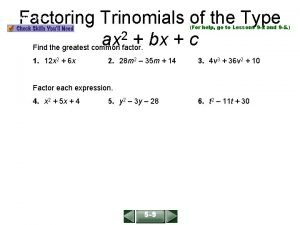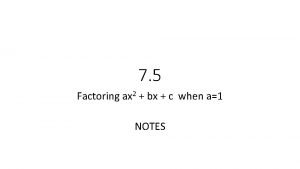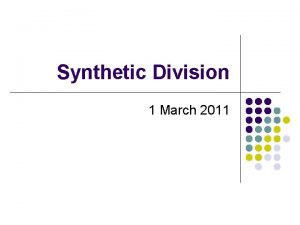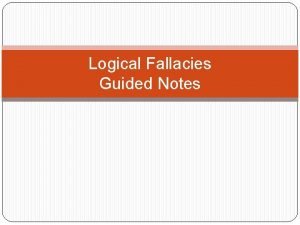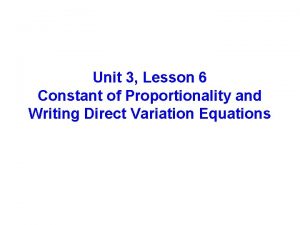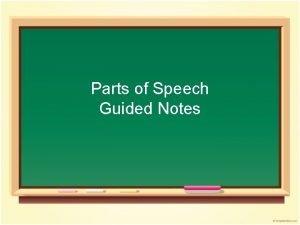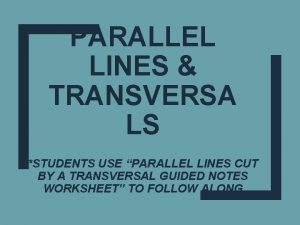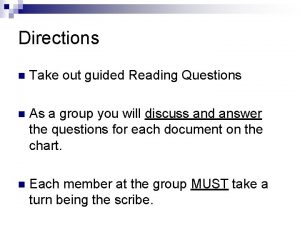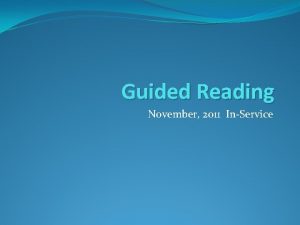Take out the guided reading notes from yesterday

















- Slides: 17

Take out the guided reading notes from yesterday and continue working on them - you have 15 minutes before we start notes (the graphs on the back of the page should look like the two graphs in that section of the book)

Motion

Motion a change in an object’s position Linear motion: motion in a single dimension (in a line). When you talk about an object’s motion, you are referring to a rate Rate: A quantity divided by time - tells how quickly something happens

Motion is Relative If something is relative, it depends on the frame of reference Frame of Reference: point of view of the observer When we discuss the motion of something, we describe its motion relative to something else. Usually, when we discuss the speeds of things on Earth, we mean the speed with respect to the Earth’s surface. Ex: how quickly a dog runs past a tree

Speed: the distance covered per unit of time. • A measure of how fast something is moving. • the rate at which distance is covered. Ex: 100 km/hr, 55 mph, 30 m/s Equation: s=d/t s = speed d = distance (m, km, cm, mi, ft) t = time (s, hr, day, minute, year, millenium )

Instantaneous speed • the speed at any given instant – Ex: speedometer Average speed the total distance covered divided by the time it takes to cover that distance Average speed does not indicate changes in the speed that may take place during a trip. BOTH instantaneous and average speeds indicate the rate at which distance is covered.

Check Your Understanding Discuss with a neighbor how motion and speed are related Discuss with a different neighbor how instantaneous speed and average speed are similar and how they are different

Velocity • When we say that a car travels 60 km/hr, we are indicating it’s speed. When we say that a car is traveling 60 km/hr to the north, we are indicating it’s velocity. Velocity: speed in a given direction • Ex: 100 km/hr East, 55 mph North, 30 m/s Southwest • Equation: v = d / t Speed is a description of how fast an object moves; velocity is how fast it moves AND in what direction.

Check Your Understanding The speedometer of a car moving northward reads 100 km/h. It passes another car that travels southward at 100 km/h. Do both have the same speed? Do they have the same velocity? Discuss with a neighbor Both cars have the same speed, but they have opposite velocities because they are moving in opposite directions.

Constant Velocity • Constant velocity requires both constant speed and constant direction. • Motion at constant velocity is in a straight line at constant speed. Changing Velocity • Constant speed and constant velocity are not the same thing. • A body may move with constant speed around a curved path, but it does not move with constant velocity because the direction changes at every instant.

Let’s do the math • We’ve practiced calculating speed when given distance and time, but can you find distance if given speed and time? – Of course you can, you just need to rearrange the speed formula so that you are solving for distance – Try it – calculate distance if given: • Speed = 8 m/s • T=2 s

• You can also find time if given speed and distance, just rearrange the speed formula to solve for time • Try it: find time if given: – S = 6 km/s, d = 30 km

Position - Time graphs • Position-Time graphs show the distance covered over an elapsed time – Aka Distance-Time graphs and Displacement-Time graphs • Time is always the independent variable

• Position (distance) is always the dependent variable • The slope of a Position-Time graph is equal to velocity – Slope = rise/run – Slope = position / time – Velocity = position / time • The steeper the slope, the faster the velocity – A positive slope is forward motion – A negative slope is moving backwards – A zero slope is NOT moving at all


Check Your Understanding Discuss with a neighbor: Which person is moving faster, the red or blue jogger? What does it mean to move faster in terms of distance? The red jogger’s line has a steeper slope and therefore a faster speed.

Check Your Understanding Are both joggers moving forwards or backwards? Forwards. The slope is positive, meaning that the distance increases over time.
 Edb net
Edb net Active note taking
Active note taking You're my kryptonite you keep making me weak
You're my kryptonite you keep making me weak Pre reading while reading and post reading activities
Pre reading while reading and post reading activities Guided notes international organizations
Guided notes international organizations Civil war guided notes
Civil war guided notes Perfect squares notes
Perfect squares notes Factoring trinomials
Factoring trinomials Factoring problem
Factoring problem Ecology guided notes
Ecology guided notes Factoring ax2 bx c
Factoring ax2 bx c Product of linear factors
Product of linear factors Logical fallacies guided notes key
Logical fallacies guided notes key Proportions guided notes
Proportions guided notes Constant of proportionality example
Constant of proportionality example Material noun
Material noun Parallel lines and transversals guided notes
Parallel lines and transversals guided notes Proving lines parallel guided notes
Proving lines parallel guided notes







